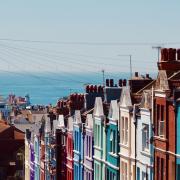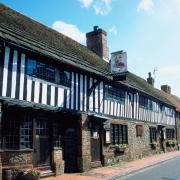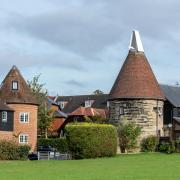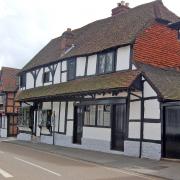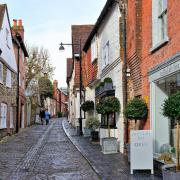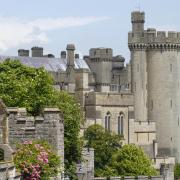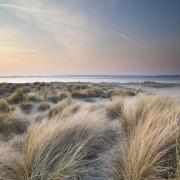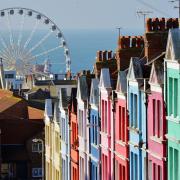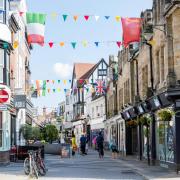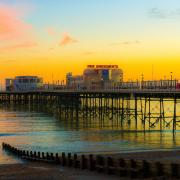In the latest installation of his Secret Sussex series, Clive Agran visits the Cinque Ports town of Rye – where the influence of France is all around
Walking round Rye’s quaint and cobbled streets it’s hard to imagine the place being anything other than peaceable and prosperous. But the genteel feel that nowadays attracts thousands of tourists conceals a rich and colourful past.
To find out the truth of what lies behind Rye’s pretty exterior, I meet Michael Carver, a history teacher turned tour guide who regularly escorts visitors around the town. Our rendezvous is outside the famous Mermaid Inn. Rebuilt as recently as 1420, it has cellars that go all the way back to 1156 which, if only walls could talk, would doubtless tell some fruity tales. Instead I’m fortunate to have Mike, who is evidently no mean raconteur and I soon sense this is going to be a lot more fun than, forgive me Mr Carrington, any of my history lessons at school.
Wandering down Mermaid Street we pass Jeake’s House. A plaque high on the wall states: “At mid-day on June 13, 1689 the foundation of this warehouse was layed, the heavenly bodies being in these positions.” Apparently Samuel Jeake, a successful merchant, was a strict Puritan who sought God’s guidance on every detail of his life. However, rather incongruously, he also believed in astrology. The Jeakes, explains Mike, were one of a number of influential families that have left their mark on Rye.
We’re inside the citadel, the fortified area which was originally surrounded by substantial walls and had four arched gates. Landgate Arch, on the south-east corner of town, is the sole survivor of the quartet. A couple of years ago some 25 tonnes of pigeon excrement were removed from it and now urgent consideration is being given as to how to preserve this ancient ruin. Mike and I are now pausing where Strandgate once stood, not far from where the Mint was at the foot of the High Street.
A significant hoard of coins that had been minted in Rye around 1115 was recently unearthed about 50 kilometres north of Paris. In response to my surprise they should turn up so far from home, Mike explains that Rye was an international trading community that conducted a lot of business with France.
France and the French feature very prominently in Rye’s history. Over 1,000 years ago King Ethelred gifted large chunks of the area, referred to in the Domesday Book as the Manor of Rameslie, to the Benedictine Abbot of Fécamp and sympathy and support in these parts influenced William the Conqueror’s decision to land his invasion force in the vicinity. Rye, which was then little more than a huge rock in the middle of the marsh, remained in Norman hands until 1247.
Battles with the French resumed less than a century later with the onset of the Hundred Years War. Most of the fighting took place in France but Rye was attacked three times, most notably in 1377 when the invaders held it for a week before burning the town down. England retained parts of France captured during the Hundred Years War until 1558 when what Mike describes as a “Tudor Brexit” saw us forcibly evicted from the continent when the French captured the last remaining English stronghold at Calais. Rye traders, many of whom lost property in France, were hit hard. Indeed, it was a double whammy as the bottom dropped out of the market in supplying goods and materials to English businesses on the other side of the Channel. Ultimately, this pushed English trading and commerce away from the continent and towards the New World leading to the age of exploration and empire.
The French had a major impact on Rye and so did the sea. A couple of incredibly violent storms in 1250 and 1287 destroyed nearby Winchelsea and diverted the Rother away from Romney. Rye benefited from Romney’s demise. About 100 years later, the sea and river combined to destroy the eastern part of the town and ships began unloading cargo just below where we are standing on what is called the Strand.
Looking out today over the flat coastal plain towards the distant sea, it’s not easy to appreciate that this was once a bustling port that could accommodate 400 moored ships and support a thriving shipbuilding industry befitting a Cinque Ports town. The now modest rivers Brede, Tillingham and Rother were once much mightier and between the 14th and 16th centuries this was the largest natural harbour in the south of England. Being directly opposite Normandy, Rye provided a key link in the strategic overseas concerns of all English kings in the medieval and Tudor periods.
However, as ships got bigger so Rye struggled to compete with deepwater ports and also suffered as a consequence of a switch in emphasis towards ports on the west coast facing the Atlantic and the New World.
As we walk up Traders Passage, which Mike thinks should more properly be called Smugglers Passage, he explains how, with the imposition of hefty duty on all manner of goods, Rye turned to smuggling. “The infamous Hawkhurst Gang was very well organised and could muster as many as 600 men to unload a ship in a couple of hours. It was also a generous employer and labourers and farm workers could earn a fortnight’s wages in a couple of hours,” he explains. The Hawkhurst Gang, who regularly met in the Mermaid, had the south coast from Kent to Dorset pretty well sewn up.
Mike likens the situation to the Prohibition era in the United States when the extreme measure of banning alcohol spawned a huge and profitable bootleg industry that enriched many criminals, corrupted the authorities and criminalised the population just as smuggling had done in 18th century England. The transatlantic link is strengthened by a quote that hangs on the back of the Ship Inn below which was uttered by an exasperated Lord Pembroke: “Will Washington take America or Smugglers England first.” Mike’s American clients particularly enjoy that. The introduction of free trade in the middle of the 19th century and Gladstone’s removal of hundreds of tariffs effectively killed off smuggling as a career.
We turn up Watchbell Street and pop inside St Anthony of Padua Roman Catholic Church. For a moment you could forget you were in Rye and imagine somewhere in Andalucia as the pretty little church is built in the classic Spanish colonial style. Designed by John Mendham, an English architect brought up in Argentina, and opened in 1930, it is believed to be the only Spanish-Romanesque church in Britain and is run by the Franciscans in Greyfriars Friary. The rood cross that hangs above the altar was the gift of Marguerite Radclyffe Hall, a famous lesbian author who lived in Rye in the 1930s.
We discuss the town’s strong literary connections as we enter lovely Church Square and admire the impressive houses that line it. More than 90 per cent of the properties within the citadel are listed. We walk past St Mary’s Church, the oldest building in Rye, and look across at Ypres Tower, which is the nearest Rye comes to a castle. The absence of a proper castle when, following the Norman invasion, Rye would have been an ideal location for one, disturbs Mike who explains the Church, who owned most of the land here, weren’t especially keen on military installations being built on their property.
Now owned by the National Trust, Lamb House is more famous as the former home of American author Henry James than it is for being where King George I stayed for a few nights in 1726 when his ship ran aground at Camber. Clearly not a fan of James, Mike quotes Mark Twain’s dig at him: “Once you’ve put one of his books down, you simply can’t pick it up again.”
E F Benson, son of the Archbishop of Canterbury and author of the Mapp and Lucia books that are recognisably based on Rye, also lived in Lamb House and was the town’s mayor in 1934. He donated a window to St Mary’s in memory of his brother, who wrote the words to Land of Hope and Glory.
Just a little way down from St Mary’s in Lion Street is the house in which John Fletcher was born in 1579. The son of the curate at Rye who later became Bishop of London and Chaplain to Queen Elizabeth I, John Fletcher was a Jacobean playwright who followed William Shakespeare as house playwright for the King’s Men. He also collaborated with Shakespeare on Henry VIII and The Two Noble Kinsmen.
The Bard himself visited Rye with his touring company in 1597. They performed at the Mermaid Inn where Mike and I enjoy a delicious lunch in the cosy ‘Giant’s Fireplace’ bar before saying adieu.
More…
• The history of Battle - The East Sussex town is inextricably connected with the most famous date in English history. So what’s new for Clive Agran to discover when he’s given a tour by the locals?




